Black holes and their environments
DOI: 10.1063/1.2774097
Black holes are increasingly taking center stage in modern astrophysics. Accretion onto these objects is an extremely efficient mechanism for extracting energy from mass—in principle, up to 30% of the accreting material’s rest-mass energy is accessible. Largely for that reason, black holes have been implicated as the prime mover in many of the universe’s most energetic phenomena, including active galactic nuclei, radio galaxies, and gamma-ray bursts. For example, an AGN, that is, an accreting black hole with a mass millions to billions of times greater than the solar mass (M ⊙) and situated at the center of its host galaxy, can have a power of 1040 W and outshine its host by a factor of thousands. AGNs and other exotic astrophysical systems provide natural laboratories for testing such fundamental physics as Lorentz invariance and general relativity. More surprising is the recent revelation that black holes seem to be important players in regulating the formation of large-scale cosmological structure. Mismatches between observations and standard theory strongly suggest that energy injection by black holes is an important part of galaxy formation.
Past and present x-ray observatories have been essential to astrophysicists’ current understanding of black holes. In this article we explore the current state and future prospects of research in black hole astrophysics, with special emphasis on what can be learned from x-ray observations.
Spacetime and spin
Solar-system tests of general relativity have achieved a high level of success, but few options exist for exploring and testing general relativity in the strong-field limit. X-ray emission lines from disks of gas orbiting black holes do allow for such explorations. And it now appears that nature has been unusually kind: Surveys indicate that approximately 70% of type 1 AGNs, those whose inclinations permit a clear view of the inner disk, show relativistic disk lines in their spectra. 1 , 2 Indeed, such lines are found in spectra of both accreting supermassive and stellar-mass black holes, the latter of which result from the deaths of massive stars. Many of the observed emission lines have energy profiles that have been strongly affected by special-relativistic Doppler shifts due to the orbital motion of the disk matter and by general-relativistic gravitational redshifting; figure 1 shows an example. Thus, not only can one explore the innermost relativistic regime near many black holes, one can also check that effects are similar over a factor of a million or more in black hole mass.

Figure 1. A relativistic disk line from an iron K transition as revealed in x-ray spectra of the active galactic nucleus MCG-6-30-15. The data were obtained with the Suzaku (black) and XMM-Newton (red) observatories. The speed of particles in orbit around a black hole can approach that of light, and special-relativistic beaming combines with the Doppler effect to create an asymmetric emission line profile. Some of the x-ray light is observed with an energy well below the transition’s rest energy of 6.4 keV because of energy losses experienced while escaping from the strong gravitational potential. Such lines are powerful tools to explore the predictions of general relativity. To display the line clearly, its flux is shown as a ratio to the continuum flux obtained from a well-determined continuum model.
(Adapted from ref. 17.)
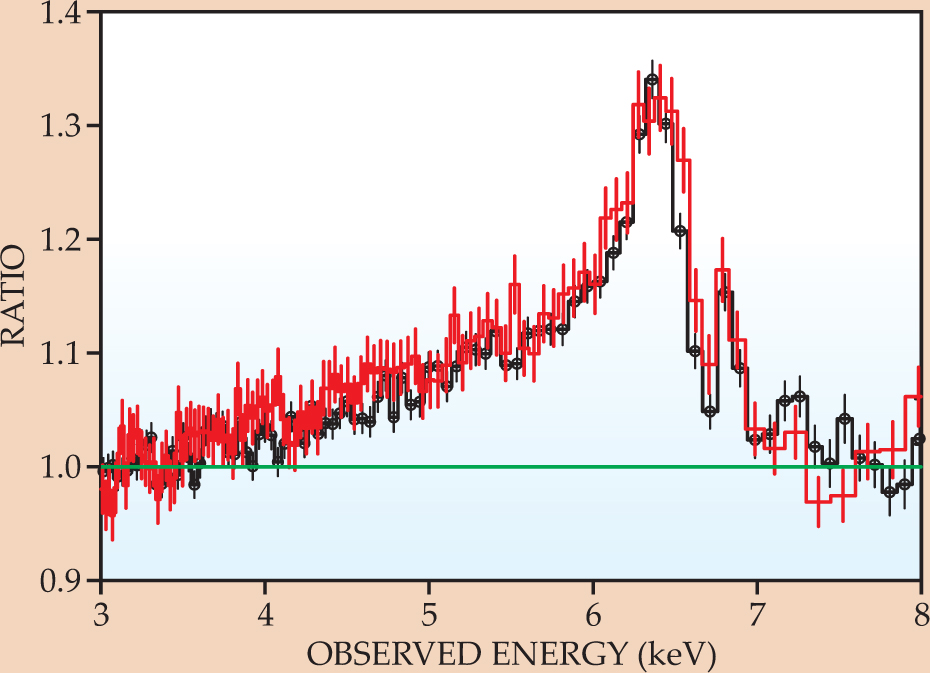
Observation of emission lines is useful because the gas flow in the accretion disks is rather simple. Astrophysicists think that the disks in the systems displaying the x-ray lines are geometrically thin, or pancake-like. As a result, radial gradients in the gas pressure are small and the gas flows closely approximate circular, Keplerian orbits (orbits determined solely by the gravitational force) in the black hole’s gravitational potential. The theory of geometrically thin, radiatively efficient accretion disks is well developed and applies to disks around white dwarfs and young stars as well as around black holes. For the purposes of probing the innermost relativistic regime around black holes, however, the details of disk physics are relatively unimportant. Rather, it is the black hole itself that has the most significant effect.
Black holes will inevitably possess angular momentum, or spin. Indeed, accretion of high-angular-momentum matter from a disk spins up black holes, and a large fraction of astrophysical black holes may have a high spin. One of the most important astrophysical effects of spin is to decrease the radius of the innermost stable circular orbit (ISCO), that is, the radius within which circular orbits around a black hole are unstable.
A black hole’s spin may be parameterized by a ≡ cJ/GM 2, where c is the speed of light, J the black hole’s angular momentum, G Newton’s constant, and M the mass of the black hole. A Schwarzschild black hole, which has no spin, has an ISCO of 6 GM/c 2. In contrast, a black hole with a = 1, the maximal possible spin, will permit orbits as close as GM/c 2—smaller than the event horizon of a Schwarzschild black hole. For a given M, the difference in the gravitational redshift at those extremal ISCOs is quite pronounced, as is the difference in the Doppler shift of matter in Keplerian orbits at the two radii.
Although studies of disk lines were opened up by the launch of the joint US–Japanese Advanced Satellite for Cosmology and Astrophysics in 1993, observations from NASA’s Chandra X-ray Observatory and the European Space Agency’s XMM-Newton have most clearly revealed relativistic disk lines from both supermassive and stellar-mass black holes. Most recently the Suzaku observatory—another US–Japanese project—has made major contributions.
The instrumental advances achieved with the new observatories coincide with theoretical advances in disk-line models. Prior line models assumed either zero or maximal spin, but the more sophisticated new models allow the spin to be calculated from data and have enabled the first reliable spin measurement: a = 0.989 +0.009 −0.002 for the supermassive black hole in MCG-6-30-15, a nearby and well-known AGN. 3 In our own galaxy, some stellar-mass black holes in binary systems, such as GX 339-4 and XTE J1650-500, may have spin nearly as high.
Admittedly, the details of how the gravitational potential energy of the accreting matter is transformed into observed radiation are complex and not fully understood. A significant fraction of the radiation is emitted essentially as blackbody radiation from the accretion disk’s surface or, more precisely, from the photosphere; that radiation gives a broad spectral peak lying in the UV band for supermassive black holes and in the soft-x-ray band for stellar-mass black holes. In both cases, however, significant power is emitted in a hard-x-ray component that has a power-law spectral form. That component is most likely produced in an energetic corona that sandwiches the accretion disk, or possibly in the base regions of an energetic jet. Irrespective of the origin, it is the irradiation of the disk’s photosphere by the hard x-rays that produces the fluorescent x-ray emission-line spectrum used to probe the strong-gravity regime.
Studies of black holes using x-ray disk lines are now poised to make progress on two fronts: strong-field gravitational effects in specific sources and black hole spin measurements in a large number of supermassive black holes. Studies of strong-field gravity might reveal gravitational light bending and such spin-related effects as rotational energy extraction from black holes via magnetic fields. 2 , 4 New investigations promise to reveal the evolution of black hole spin over cosmic time scales, and thereby the coevolution of central supermassive black holes and their host galaxies.
Observations already offer great hope. Alina Streblyanska and colleagues summed the light observed by XMM-Newton from supermassive black holes out to a redshift z of 2 and found relativistic lines in the averaged spectrum. 5 With larger telescopes, it will be possible to establish spin constraints at the redshift at which most black holes acquired most of their mass. Those constraints will enable tests of models suggesting that accretion is essential to driving spin and that black hole mergers act to drive down spin.
Constellation-X
The Constellation-X Observatory , scheduled for launch in about 10 years, is the planned successor to NASA’s Chandra X-ray Observatory . The National Academies’ decadal survey Astronomy and Astrophysics in the New Millennium (National Academies Press, 2001) ranked Constellation-X as a priority second only to the James Webb Space Telescope among space missions. Although a broad range of scientific investigations will be possible with Constellation-X, its central objects of study will be the nature of spacetime close to black holes, the fate of matter there, and the coevolution of black holes and galaxies. Constellation-X will also be able to use galaxy clusters to investigate the nature of dark energy with an accuracy comparable to supernova-based studies; thus, it will also complement ground-based dark-energy surveys.
When the Keck 10-m telescopes in Hawaii were constructed, they drew on the technology and results of earlier 1-m and 2-m optical and IR telescopes to achieve a vastly improved collection area. In much the same way, Constellation-X ‘s high-resolution spectrometers will obtain 100 times more light per unit time from black holes than is now possible with Chandra and XMM-Newton ; the details of effective light-collection area as a function of energy for the three observatories are given in the accompanying plot (courtesy of the Constellation X-ray Mission and NASA’s Goddard Space Flight Center).
Optical and x-ray observatories have important and interesting differences. For example, a parabolic mirror with its symmetry axis parallel to incoming light will efficiently reflect and image optical light, but such a configuration does not focus x rays, which are absorbed for all but glancing incidence angles. Instead, x-ray light is focused through small-angle deflections. X-ray mirrors are therefore conical and change the path of incoming light only slightly—by less than a degree. To achieve focus across a significant field of view, two reflections are needed, first from a paraboloid and second from a hyperboloid. Because x-ray mirrors are conical, the collecting area can be built up by nesting concentric mirrors. Whereas Chandra is a single telescope with four concentric mirrors, Constellation-X will house four independent telescope systems of 163 concentric mirrors each (see figure 3).

Figure 3. Space-borne Constellation-X , in an artist’s rendition. This planned successor to the Chandra X-ray Observatory will focus on the spectroscopy and cosmic evolution of black holes. Its main unit will be approximately 10 m in length and 4.5 m in diameter and will house four independent x-ray telescopes.
(Courtesy of the Constellation X-ray Mission and NASA’s Goddard Space Flight Center.)
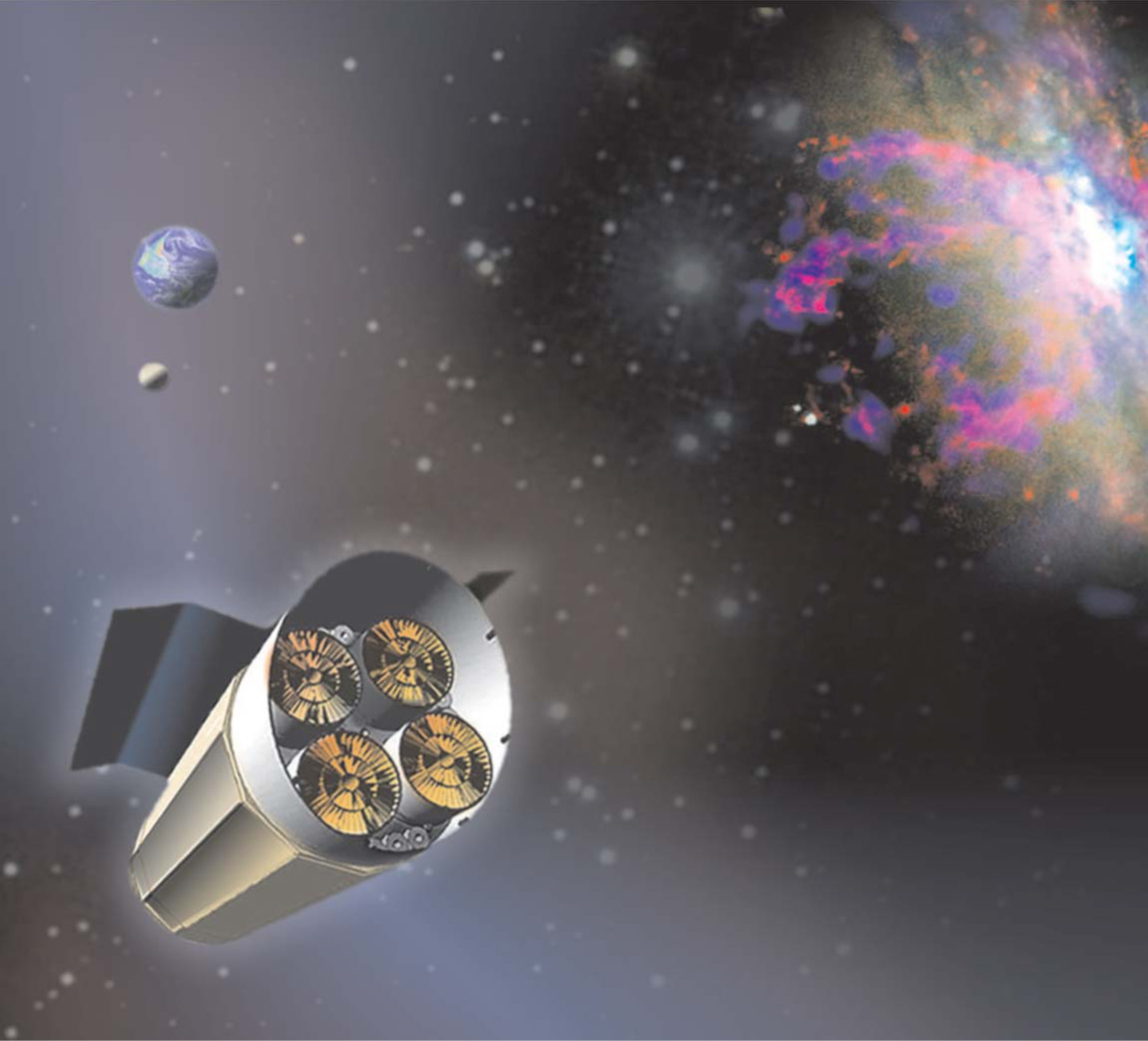
Modern optical observatories focus light onto CCDs that are similar in many ways to those used in commercial electronics such as digital cameras. Spectroscopic instruments are necessarily separate. But because x rays have so much more energy than do optical photons, imaging and spectroscopic functionality can be combined. The key idea is that optical photons only liberate a few electrons in an optical CCD, whereas a single x-ray photon has enough energy to liberate orders of magnitude more electrons in an x-ray CCD. Instead of CCDs, Constellation-X will use an x-ray calorimeter for spectroscopy. That imaging instrument will deliver an energy resolution of approximately 1 part in 2500 in the iron K-line band; x-ray CCDs, in contrast, deliver a resolution of about 1 part in 50.

By virtue of its large collecting area and new spectrometer, Constellation-X will be in a position to achieve major advances. For the first time, scientists will be able to look at supermassive black holes and study relativistic disk-line variability on suborbital time scales. That will enable quantitative probes of the spacetime metric close to black holes and, for at least 10 supermassive black holes, will allow true strong-field tests of general relativity. Furthermore, Constellation-X will be able to obtain spin measurements for more than 300 supermassive black holes, including some with redshifts greater than 2.
The presence or absence of intermediate-mass black holes in the present-day universe should be revealed with Constellation-X. Scientists will be able to study in detail off-center black holes in nearby galaxies, just as they presently study stellar-mass black holes in the Milky Way.
In addition, Constellation-X should lead to a dramatically increased understanding of the large-scale environmental impact of black holes. Improved sensitivity and spectral resolution are essential if astrophysicists are to better understand the interaction of supermassive black hole jets with hot gas in galaxy clusters and the properties of galaxy clusters in general. Constellation-X will deliver both and will allow for the study of turbulent and organized motions within the intracluster gas. Researchers will also be able to determine in detail the temperature structure and composition of the cluster gas—measurements that will shed light on the mystery of how the energy delivered by the jets is evenly shared throughout the cluster core.
Intermediate-mass black holes
The most convincing evidence for black holes—perhaps nature’s most exotic objects—is found using the most mundane tool: Kepler’s third law. Stellar-mass black holes are the endpoints of single massive stars. They are discovered in binary systems, where mass transfer from a companion star allows the black hole to accrete matter and flare in x rays. Radial velocity curves—tangential velocity versus radius—of the binary obtained with optical spectra place limits on the mass of the black hole. If the lower mass limit on the primary (that is, the accreting member of the binary) exceeds the upper limit for neutron stars, a limit set in part by the requirement that the internal sound speed be less than c, the primary is deemed to be a black hole. Similarly, the best evidence that supermassive black holes inhabit galactic centers comes from the elliptical orbits of single stars around Sagittarius A*, the black hole with mass 3 × 106 to 4 × 106 M ⊙ at the center of the Milky Way (see Physics Today, February 2003, page 19
At present, astrophysicists have no conclusive proof of black holes with masses in the range of 102–104 M⊙. However, the discovery and study of such intermediate-mass black holes would reveal a great deal about galaxy evolution and stellar clusters. In the very early universe, extremely massive and metal-poor stars may have left intermediate-mass black holes; theoretical considerations suggest that on the order of 100 such intermediate-mass black holes might inhabit typical galaxies today. 6 The merger of a number of intermediate-mass black holes may have created the seeds of the supermassive black holes now seen in galactic centers. In an alternate mechanism, intermediate-mass black holes could result from mergers in very dense star clusters. 7
Although conclusive evidence for intermediate-mass black holes may be wanting, circumstantial evidence does exist. An upper “Eddington limit” on the luminosity of any long-lived astrophysical system is set by the requirement that radiation pressure not exceed gravitational pressure. For a black hole of mass M accreting hydrogen, the limiting luminosity L Edd is about 1.3 × 1031 (M/M ⊙) W. Thus, observed luminosity can be used to set a lower limit on the mass of an accreting black hole.
In nearby spiral galaxies, observations from Chandra and XMM-Newton are revealing a class of off-galactic-center sources with an apparent x-ray luminosity LX of at least 1033 W. Moreover, in some of those cases, the spectra of the sources can be decomposed to reveal a blackbody contribution from a putative accretion disk that is far cooler than typically seen for our galaxy’s stellar-mass black holes with luminosities near their Eddington limit. Accretion-disk temperature scales inversely with black hole mass (T ∝ M −1/4) since the radiating disk area increases faster than the luminosity. The cool spectra thus appear to suggest the presence of intermediate-mass black holes. On a different front, studies of the x-ray variability in some of the high-luminosity sources find characteristic time scales to be longer than in stellar-mass black holes, again suggestive of intermediate-mass black holes.
Spectral decompositions can be difficult, however, and alternative descriptions of some spectra are not excluded. Moreover, the analysis of variability time scales can also be difficult and imprecise. And even the suggestive luminosities could be a consequence of relativistically beamed or mechanically focused emission that, when isotropic emission is assumed, leads to a falsely high deduced luminosity. At present, only one case—M82 X-1, with an LX of about 1034 W—ranks as a strong candidate to be an intermediate-mass black hole; see figure 2.

Figure 2. The central region of the galaxy M82, as depicted in two x-ray images obtained from the Chandra X-ray Observatory. The green cross indicates the center of the galaxy as determined by gaseous and stellar dynamics. A variable x-ray source is clearly evident near the middle of the images. The off-galactic-center location of the source, its peak x-ray luminosity, and its variability characteristics suggest that it is an intermediate-mass black hole. Each image represents a window approximately 30 arcseconds across; the intermediate-mass black hole is at least 600 light-years from the center of M82.
(Courtesy of the Chandra X-ray Observatory Center.)
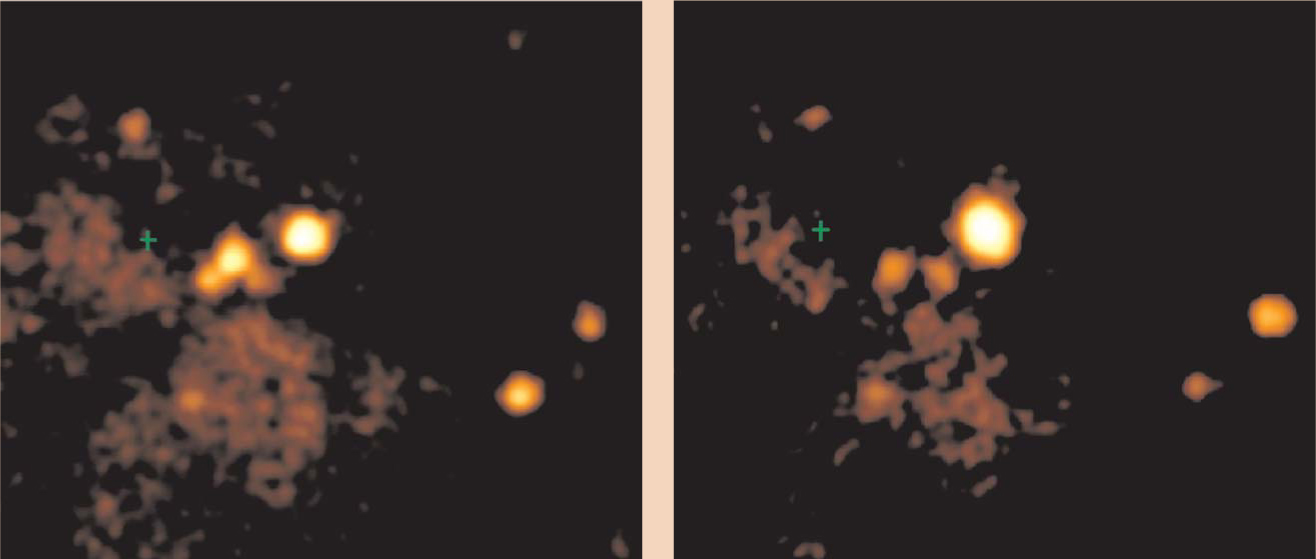
Optical radial velocity curves might be obtained for the high x-ray luminosity sources in the coming years but, in all probability, only rarely. Definitive optical counterparts are not yet known in many cases, and robust radial velocity curves are exceptionally difficult to obtain when a source is actively accreting—quiescent periods are far better for that task. Improved x-ray observations will likely be pivotal in determining if any luminous sources in nearby galaxies are indeed intermediate-mass black holes.
Black hole disks
Accretion onto supermassive black holes in galactic centers represents a major source of ionizing radiation. Radiation pressure and matter outflows from repeated periods of intense accretion onto the central supermassive black hole are thought to be intimately related to star formation in galaxies, and may be responsible for quenching star formation in old galaxies. 8 Black holes and galaxies evolve together. It is therefore vital to understand the disk accretion process through which black holes gain most of their mass and flood the universe with ionizing radiation.
Accretion disks perform a subtle and fascinating trick. The astrophysical plasma in the disk has an extremely low viscosity, so it is not obvious how the matter actually sheds its angular momentum and accretes. Astrophysicists now understand that magnetic fields are central to the angular momentum transport. Two general mechanisms are responsible. Following seminal work by Nikolai Shakura and Rashid Sunyaev, who suggested that accretion proceeds due to a high effective viscosity created by fluid turbulence, 9 Steven Balbus and John Hawley identified a powerful magnetohydrodynamic instability that drives the turbulence. 10 A blackbody spectrum characteristic of internal viscosity is observed in a number of astrophysical settings with disks, from young stellar objects to black holes. However, such a spectrum is not an unambiguous signature of turbulence caused by magnetic effects. Angular momentum can also be carried away from the disk by a wind that flows along magnetic field lines. 11
New observations with Chandra and XMM-Newton are enabling scientists to study black hole disk physics in detail. High-resolution absorption spectra reveal ionized disk winds in many systems, with typical velocities of 100–1000 km/s; in some special cases, wind velocities can be an order of magnitude higher. If those winds fill an appreciable fraction of the volume close to the black hole, mass outflow rates comparable to mass inflow rates are sometimes implied. For one stellar-mass black hole 12 and at least one supermassive black hole, 13 observations suggest that magnetic fields are the key ingredient driving disk accretion, whether through magnetohydrodynamic turbulence, winds, or a combination of the two.
As noted earlier, gas in thin accretion disks flows in approximately circular, Keplerian orbits. Now x-ray disk-line observations of supermassive black holes, obtained from XMM-Newton , are beginning to reveal cyclic behavior consistent with inner disk orbits. The much shorter time scales intrinsic to stellar-mass black holes are more suitable for such studies, and observations have delivered. Since its launch in 1995, NASA’s Rossi X-ray Timing Explorer (RXTE) has been one of the workhorses in x-ray astronomy. It is ideally suited to studies of transient and short-time-scale phenomena. Among its many accomplishments is the discovery of quasi-periodic millisecond variability in stellar-mass black holes, consistent with Keplerian orbits in the inner disk. General relativistic effects can and likely do play a role in generating those oscillations, but the broad agreement of the observed frequencies with simple Keplerian orbital time scales is undeniable. The imaging spectrometer scheduled to fly on Constellation-X will offer similar collecting area and frequency coverage along with dramatically improved spectral resolution and sensitivity. The
When you’re a jet
The existence of disk winds demonstrates that black holes do not merely swallow matter. Indeed, they can serve as cosmic accelerators, launching jets of matter to ultrarelativistic speeds. Although researchers have long been able to image those jets, particularly at radio frequencies, a number of questions have endured and, in recent years, come into sharp focus. How do black holes drive jets? What fraction of the accretion energy is released as kinetic energy in jets versus radiation? What impact do jets have on environments close to black holes? Now, with a combination of x-ray and radio observations, astrophysicists are beginning to address those questions. The answers are surprising. Averaged over time, black holes appear to channel a fixed fraction of accreted energy into radiation and jets, though sometimes they channel far more than the typical amount of energy into jets. And work done on local environments by black hole jets can have truly profound effects.
Disk accretion onto black holes and nonthermal processes tied to the disk are thought to drive x-ray emission from black holes. In contrast, radio emission appears to be dominated by synchrotron emission from the jet. By proxy, then, one can study inflow and outflow connections in black holes via x-ray and radio emissions and correlations between the two. Stellar and gas dynamics yield reliable constraints on black hole masses.
In the past few years, two teams have independently presented evidence that a specific nonlinear correlation exists between black hole mass, x-ray luminosity, and radio luminosity. 14 , 15 The relation holds over orders of magnitude in each quantity; in particular, it remains true for both stellar-mass black holes and supermassive black holes and so connects the two disparate classes. This correlation among three parameters is called the fundamental plane of black hole activity (see figure 4).

Figure 4. The fundamental plane of black hole activity. Black holes convert a specific fraction of accretion energy into radiation, traced by the x-ray luminosity L X, and jet kinetic energy, traced by radio-emission luminosity L R. The plot shown here includes black holes that inhabit four distinct classes: stellar-mass black holes (circles), low-ionization nuclear emission line regions and transition objects (diamonds), Seyfert active galactic nuclei (triangles), and quasars (stars). Black hole masses M, measured in units of the solar mass and indicated by color, range over more than seven orders of magnitude. Luminosities are in erg/s.
(Adapted from ref. 14.)
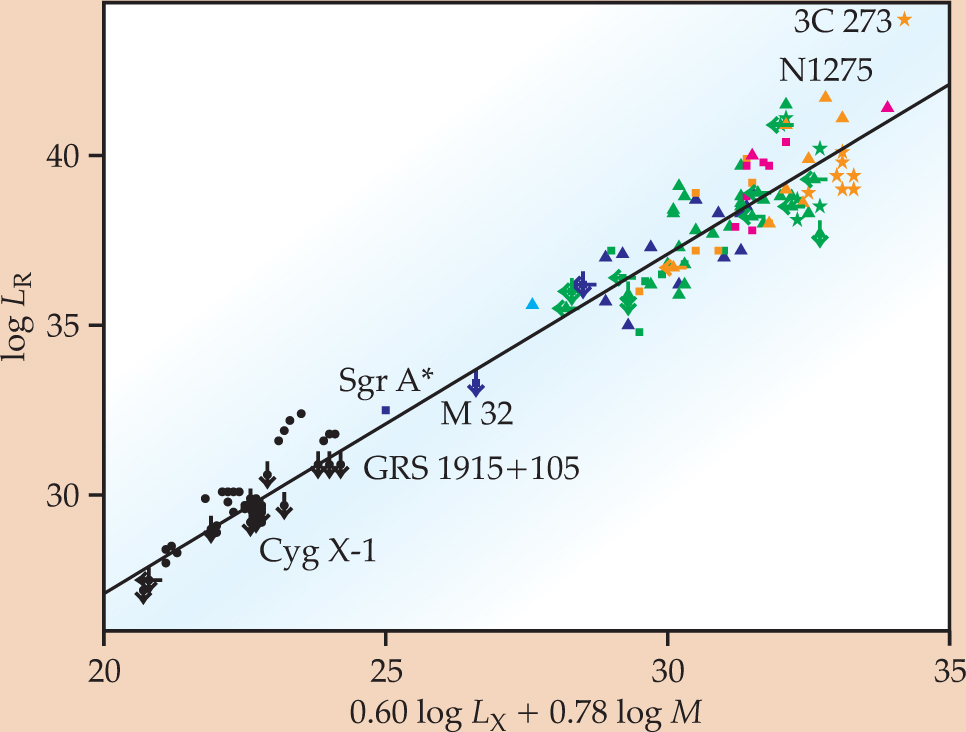
The implications of the fundamental plane are simple and profound. X-ray images obtained from Chandra have made it possible to quantify the distribution of black hole x-ray luminosities as a function of cosmic redshift. That is, astrophysicists can quantify, over cosmic time scales, a major contribution to the density of steady ionizing radiation that is of central importance in shaping galaxies and the growth of structure. The fundamental plane allows astronomers to begin to piece together the kinetic luminosity distribution of black holes—an entirely new angle on how black holes shape their host galaxies and nearby groups of galaxies.
What impact do jets have? On the largest scales, they influence the evolution of galaxy clusters—the largest bound objects in the universe.
In optical light, clusters appear as collections of hundreds or thousands of galaxies bound to each other. But a counterintuitive hierarchy exists in galaxy clusters: The baryonic mass implied by the optical light that arrives from the individual galaxies is not the bulk of the baryonic mass. Most of the baryonic mass exists in the form of tenuous gas between galaxies, which is heated to x-ray temperatures (tens of millions of kelvin) by the gravitational potential. And the total baryonic mass is dwarfed in importance by dark matter.
X-ray observations are necessary if one is to understand the baryonic content of galaxy clusters. In x-ray images, clusters are not discrete collections of point sources but extended glowing objects with high surface brightness. In some galaxy clusters, the hot gas bears the imprint of the supermassive black hole at the heart of the central galaxy. A dramatic example, from the Perseus cluster, is shown in figure 5. That image and others from Chandra reveal in the hot x-ray gas within the cluster distinct ripples that correspond to repeated periods of jet activity driven by active accretion onto the central supermassive black hole. Chandra observations of other clusters have exhibited cavities in the x-ray gas that match the contours of powerful jets revealed in radio bands. 16

Figure 5. The Perseus cluster of galaxies, as seen in a Chandra X-ray Observatory image. The clearly visible shocks and ripples in the hot intracluster gas arise from powerful outbursts of the supermassive black hole at the heart of the central galaxy, Perseus A. The figure represents a window 4.7 arcminutes across, and the most distant shocks have traveled approximately 300 000 light-years from the black hole.
(Adapted from ref. 18, courtesy of the Chandra X-ray Observatory Center.)
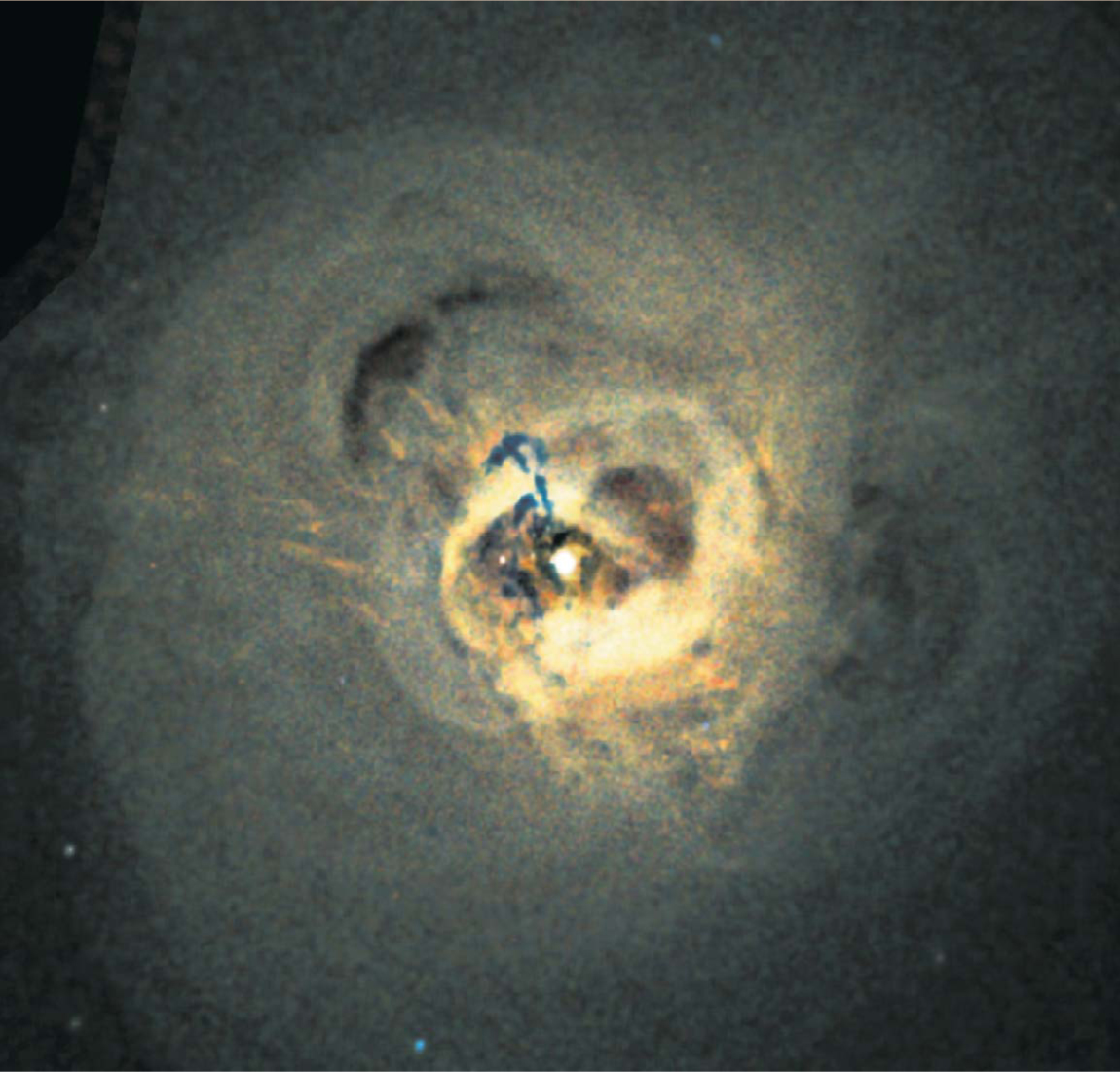
The black hole jets are doing work on the cluster gas. Theoretical calculations show that sound waves and jets can supply enough energy to stem the flow of cold gas into the center of clusters, which in turn inhibits star formation and alters the course of galaxy evolution.
High-energy astronomy has been markedly advanced by the current generation of x-ray observatories. X-ray observations of black holes have, for example, fulfilled their promise as a means to explore strong gravitational fields. However, the discoveries fostered by current missions have not been limited to explorations of gravitation. Astronomers have learned that black holes do not just affect the spacetime in their immediate vicinity; rather, they can have profound effects over scales as large as clusters of galaxies. Moreover, black holes strongly influence how galaxies and large-scale structure evolve over cosmic time scales. Those discoveries and successes lay a firm grounding for future x-ray missions such as Constellation-X or the European Space Agency’s proposed X-ray Evolving Universe Spectroscopy observatory, which will probe general relativity and black holes in fine detail.
References
1. K. Nandra et al., Astron. Notes 327, 1039 (2006). https://doi.org/10.1002/asna.200610641
2. J. N. Reeves et al., Astron. Notes 327, 1079 (2006). https://doi.org/10.1002/asna.200610696
3. L. W. Brenneman, C. S. Reynolds, Astrophys. J. 652, 1028 (2006). https://doi.org/10.1086/508146
4. J. Wilms et al., Mon. Not. R. Astron. Soc. 328, L27 (2001); https://doi.org/10.1046/j.1365-8711.2001.05066.x
G. Miniutti, A. C. Fabian, Mon. Not. R. Astron. Soc. 349, 1435 (2004). https://doi.org/10.1111/j.1365-2966.2004.07611.x5. A. Streblyanska et al., Astron. Astrophys. 432, 395 (2005). https://doi.org/10.1051/0004-6361:20041977
6. P. Madau, M. J. Rees, Astrophys. J. Lett. 551, L27 (2001). https://doi.org/10.1086/319848
7. M. C. Miller, D. P. Hamilton, Mon. Not. R. Astron. Soc. 330, 232 (2002); https://doi.org/10.1046/j.1365-8711.2002.05112.x
S. F. Portegies Zwart et al., Nature 428, 724 (2004). https://doi.org/10.1038/nature024488. T. Di Matteo, V. Springel, L. Hernquist, Nature 433, 604 (2005). https://doi.org/10.1038/nature03335
9. N. I. Shakura, R. A. Sunyaev, Astron. Astrophys. 24, 337 (1973).
10. S. A. Balbus, J. F. Hawley, Astrophys. J. 376, 214 (1991). https://doi.org/10.1086/170270
11. R. D. Blandford, D. G. Payne, Mon. Not. R. Astron. Soc. 199, 883 (1982).
12. J. M. Miller et al., Nature 441, 953 (2006). https://doi.org/10.1038/nature04912
13. S. B. Kraemer et al., Astrophys. J. 633, 693 (2005). https://doi.org/10.1086/466522
14. A. Merloni, S. Heinz, T. Di Matteo, Mon. Not. R. Astron. Soc. 345, 1057 (2003). https://doi.org/10.1046/j.1365-2966.2003.07017.x
15. H. Falcke, E. Körding, S. Markoff, Astron. Astrophys. 414, 895 (2004). https://doi.org/10.1051/0004-6361:20031683
16. W. Forman et al., Astrophys. J. 635, 894 (2005). https://doi.org/10.1086/429746
17. G. Miniutti et al., Publ. Astron. Soc. Jpn. 59, S315 (2007).
18. A. C. Fabian et al., Mon. Not. R. Astron. Soc. 344, L43 (2003). https://doi.org/10.1046/j.1365-8711.2003.06902.x
More about the Authors
Jon Miller (jonmm@umich.edu
Jon M. Miller. 1 University of Michigan, Ann Arbor, US .
Christopher S. Reynolds. 2 University of Maryland, College Park, US .
